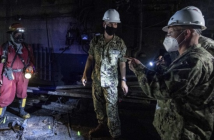Wesley Clarke-Sullivan, the humanitarian and disaster relief manager at Icon, discusses the company’s LifeSaver water purification system that is scalable, rugged and long-lasting for military and humanitarian relief applications with Defense & Aerospace Report Editor Vago Muradian at the DSEI 2019 conference and tradeshow in London. Our coverage is sponsored by L3Harris and Leonardo DRS and in partnership with Clarion Events — DSEI’s organizer — and working with the UK Department of International Trade’s Defence & Security Organisation to bring our audience the best in British defense and security.
Vago Muradian: Welcome to the Defense and Aerospace Report. I’m Vago Muradian covering the 20th anniversary edition of DSEI, one of the world’s truly great defense and security shows at this terrific venue at the Excel Center in London on the waterfront. Our coverage here is sponsored by L3Harris and Leonardo DRS, and we’re partnered with Clarion Events, the organizer of this great event and many others all around the world. And we’re working together with the UK Department of International Trade, Defence and Security Organization to bring you the very best of British defense.
It’s our pleasure to be talking to Wesley Clarke-Sullivan who is the Humanitarian and Disaster Relief Program Manager at Icon LifeSaver, although LifeSaver I think now would probably be the better way to put it.
Wesley Clark-Sullivan: LifeSaver for sure.
Muradian: Wesley, tell us about this incredible technology you have. There’s only one other guy in the world that can not just filter water but purify water and rid it of viruses, useful in a military combat application, vital in a disaster relief application. And you guys do it actually at a price point that nobody else does. So talk to us about the Liberty System and all the different, you know, Liberty is one piece of it. Then you’ve got the Jerry Can version, and then you’ve got one that is even a semi-permanent solution for a lot of places who are devastated, or places where you need water over a long period of time.
Clarke-Sullivan: Thank you. The technology for LifeSaver was developed 12 years ago, and the three core tenets of it were firstly, it needed to be able to remove a virus as well as bacteria and protozoa. That’s what makes our products water purifiers. So we have to remove virus.
We also didn’t want to need to rely on power or chemicals. So we needed to just be able to do a physical removal of those contaminants.
Thirdly, it needed to be fail-safe in that when the product stops working the user knows that it’s no longer effective. The way we do that is that the membranes we use will clog up eventually, and the water will stop coming out to the user. That’s when you can replace the cartridge at that point.
Muradian: And that as actually, when we did a little bit of the pre-brief, I was like wait a minute, how do you know that the last time you pump it isn’t the time when you’re going to come down with some deadly virus.
You’re the only one who you can carry water with, right?
Clarke-Sullivan: Exactly. Using this hollow fiber membrane technology, the pores in our membranes go down to a size approximately 15 nanometers, and the smallest water-borne microbiological contaminant is virus which will be about 20 nano meters.
So if you imagine a tennis ball, it’s a virus. The holes in our filters are the tennis racket. Only water can pass through. So it goes safe to the user. It’s medically safe, sterile water.
Muradian: But you guys also have a lot of other extremely innovative features that allow you to use this. So walk us through how the whole little system works including the way you guys have set it up so that it goes directly into a bottle or directly into your mouth without actually ending up being contaminated.
Clarke-Sullivan: Exactly. To avoid cross-contamination which can easily occur when you’re dealing with potentially dangerous water, there’s two ways you can use this bottle. You can screw the base off and now you can scoop water up or pour it directly in to there. Then you put the base back on, use the built-in pump to create air pressure, and then obviously the lid is here to seal the drinking area. So this is the area that you want to keep contaminant free.
So as well as having the lid to protect it, the materials from the filter beyond here are all infused with SteriTouch which is an antimicrobial material to stop growth in this area. Nor do your hands have to touch the drinking spout, because we have a water valve there. So you simply turn the valve and that will release a steady stream of pressurized water.
Muradian: And the reverse thread here that’s for the cap also fits a Nalgene bottle.
Clarke-Sullivan: A standard wide-mouth bottle. A Nalgene hydro flask can screw right on there. That’s when you, the secondary use with the scavenger hose comes in useful. If you pump the hose on there and throw that into the water source, now you don’t have to bend down and switch the water at all. So like you say, if you screwed a bottle into there, it’s as easy as pumping directly into that bottle and you can fill up containers for your whole group with just one Liberty bottle. That’s a flow rate of about one liter, 1.2 liters per minute. So you’re not going to be hanging about for a long time.
Muradian: And at half a liter in that bottle and two — so you can do 4,000 cycles, right? So if you’re doing —
Clarke-Sullivan: We advise that this will do up to 2,000 liters in its lifetime before the filter will clog up and then you can replace the cartridge. So yeah, with this being 400 mil capacity, it’s a little bit over 4,000 uses.
Muradian: That’s right. 400 mil I should have said. Darn that whole metric thing.
This is the Jerry Can version. Show us how this system works.
Clarke-Sullivan: All our products use the same membranes, just on a larger scale. On the tap side here, which is where the water will be delivered, this is where the filter is housed. So this is the same filter technology that’s found in the Liberty, but this is ten times more membrane. So where this will do 2,000 liters, the Jerry Can will do 20,000 liters or just over 5,000 gallons.
Again, this will eventually block up and you can replace the cartridge.
The flow rate on this is about four, four and a half liters per minute, so much quicker than the Liberty. And this can hold 18.5 liters. So it’s basically a standard Jerry Can size, it’s just that with this you can store water and then bring it safe to drink at the same time.
Muradian: And the last one, which you very artfully put it in front of the big water tank, by the way. Very nicely done. Tell us about this big one which is actually almost like a semi-permanent installation for a lot of places.
Clarke-Sullivan: It’s still light and portable. Not as light as the Liberty, but close. So what you can do is with this, this is our first product which doesn’t have a built-in pump. This works with gravity or using a pressurized feed that you would just plumb straight into this, so it’s literally a plug and play. Developing countries often store water in towers such as this, at height, and so what we’ve decided to do is use that water and use that height. The gravity of the weight of the water does all the hard work. So where these needed air pressure to force it through, the water will now, if you just turn the tap, the water flows through. A great flow rate.
Because this whole thing is just the membrane, this can do 500,000 liters which as you can see on there, for a community of about 100 people it would last a little bit over four years.
Muradian: One of the questions is on economy. Your bottle, if I go on your web site and want to order it, it’s $100 in order to do it. How much is the refill?
Clarke-Sullivan: About half that.
Muradian: About half that. But I’ve got a lot of portable water. So if I’m a camper or I’m an adventure guy. But if you think about it, right now the way we do it there are so many people who have been devastated in Hurricane Dorian in the Bahamas, and everybody is flying water around at the end of the day, whereas actually you’ve got a lot of people who are surrounded by water, they just can’t consume any of that water.
How is the conversation going? I know there are some innovators, even going back ten years ago my friend Lynn Wells who as at the National Defense University, was one of the most innovative people I know, and one of the things he was saying is, it’s cheaper to actually drop off a whole bunch of these systems and leave them in a community than fly water around a disaster relief area.
Clarke-Sullivan: Yes.
Muradian: Are we making any progress in terms of how people think about this? How many of these could you put on a Chinook and drop off or drop in various places, or literally, with instructions on them, throw them out of the side of an aircraft as opposed to flying tons of water. And then once the person finishes it all they are, as you joked but rightfully said, are stuck with an empty water bottle.
Clarke-Sullivan: It’s a plastic bottle which contributes to ecological damage now.
So you’re right, we can get 24 of these on one pallet and you could fill a plane with probably 20 of those pallets. So one pallet with 24 of these on would do 12 million liters. Imagine how many planes you would need to put 12 million bottles of water on. You’re shipping water around the world, it’s not efficient in weight. And like you say, you can drink it once and then all you’ve got is an empty water bottle. Whereas these are reusable for years.
Muradian: Are you, as you brief people in government, whether in the UK or elsewhere, is the light going on and going like yeah, you know, what? This make sense.
Clarke-Sullivan: A little, yeah, a little. Maybe not to the extent that we’d like.
So we do deal with the UK government DFID and also [OCSAN], so they hold thousands of our units at any one time, and when there is a disaster they’re able to respond as quickly as possible and then they’ll come to us after that say it’s time to replenish some stock. But more could be being done around the world.
And the case of keeping the stock at these points where these disasters are likely to happen, you know, and those governments just being preempting these disasters and not allowing them to happen and then going oh, what can we do now?
Muradian: And it has a very extensive shelf life, right? So once you guy it, you can store it.
Clarke-Sullivan: Exactly, yes. These will last years. And we can actually aluminum foil seal both the product and the cartridges which means they will last up to 10 years.
Muradian: Before we go, I know there are going to be a lot of people who are going to see this and they’re going to say wait a minute, where do I get this? Because I mentioned your website. Where can people find your product?
Clarke-Sullivan: The website is IconLifeSaver.com. You can go there and you can purchase our products on there. And if you’re interested in the humanitarian side of what we do, there’s an email address, info@IconLifeSaver.com, and you can get in touch and maybe we can work together.
Muradian: Also retailers have them as well. So can folks find these in stores as well?
Clarke-Sullivan: We’re working on a distribution deal at the moment in the U.S. so you should be seeing these in stores all over the place over the next year or two.
Muradian: But you can’t say where yet.
Clarke-Sullivan: Not just yet. Very close, but not just yet.
Muradian: Wesley Clarke-Sullivan, thanks very much for joining us. We really appreciate it.
Clarke-Sullivan: Thank you.
30



